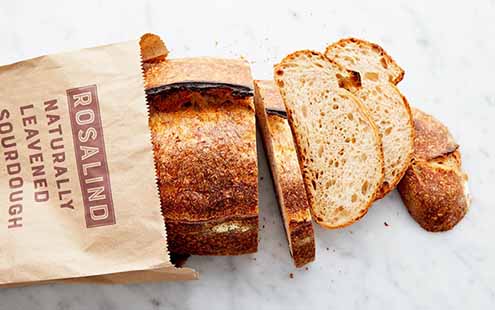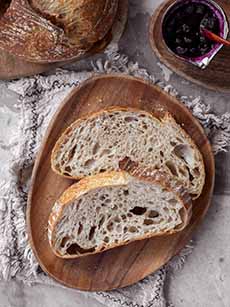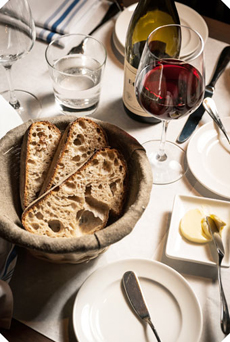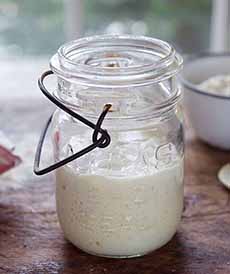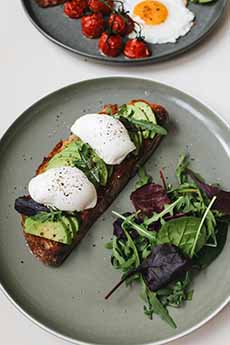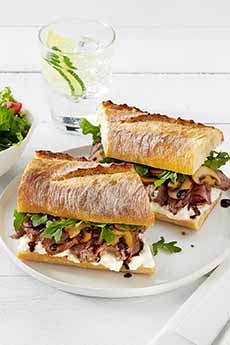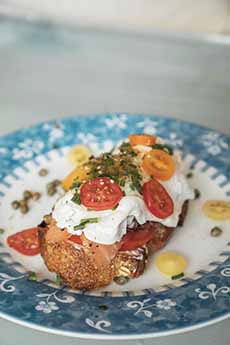The History Of Sourdough For National Sourdough Bread Day
|
April 1st is National Sourdough Bread Day. (There’s also an entire month devoted to sourdough: Sourdough September, and Real Bread Week, beginning the second last Saturday to the last Sunday in February.) Sourdough bread is the oldest form of leavened bread, born in ancient Egypt, improved in ancient Greek and Roman bakeries, “the” bread of medieval Europe, popularized in the U.S. during the San Francisco Gold Rush, and reborn in the modern artisan bread movement. Its history spans 6,000 years and multiple continents. The history of sourdough is below. The dough of sourdough is made by a long fermentation of dough, using naturally occurring lactobacilli bacteria and wild yeasts (other types of breads use cultivated yeasts, which became available only in the 19th century). In comparison with breads made with cultivated yeast, sourdough usually has a mildly sour taste and aroma, the result of the lactic acid produced by the lactobacilli. The preparation of sourdough begins with pre-fermenting, using a “starter” made from flour and water (the starter is also known as levain, the chief, chef or head). It can be a fluid batter or a stiff dough, as the ratio of water to flour varies by baker. The starter helps to develop the uniquely tart flavor of sourdough bread. Starters are maintained for years, even generations. The colony of bacteria and yeast inside the dough is kept alive by the baker, who needs only a piece of it to bake a new batch of bread. If you bake bread in a bread machine, note that the rise time of most sourdough starters is longer than that of breads made with baker’s yeasts. Thus, sourdough typically doesn’t work in a bread machine; you need to use conventional baking techniques. > September is Sourdough September. > The year’s 20+ bread holidays. > Here’s how to make your own sourdough starter. > The different types of bread: a photo glossary. Bread production has relied on the use of sourdough as a leavening agent for most of human history‡ (the alternative to leavened bread was flatbread, such as dosa, inerja, lavasch, and tortillas, among numerous others). The development and use of [cultivated] baker’s yeast as a leavening agent dates back only to the mid- to late-19th century. For the millennia before the introduction of commercial yeast, bakers relied on wild yeasts and lactic acid bacteria—naturally present in flour and the environment—to get bread to rise. Left on the windowsill, as it were, they fermented in a mixture of flour and water, creating the rise. Otherwise, they used barm, the frothy foam that rises to the top of fermenting beer or ale. Before commercial yeast existed, bakers often skimmed this foam to use as a natural leavening agent for bread. The ancient Egyptians were leaders in bread baking, and archaeologists believe sourdough bread originated there, circa 4,000 to 3,500 B.C.E. Each village often had a communal oven*, since ovens in individual homes were One of the oldest sourdough breads was found in a Swiss excavation site dating to 3700 B.C.E. Bread was an essential staple, used to pay workers partly in bread and beer. The process spread along trade routes through the Middle East and into what is now Europe. In Ancient Greece, circa 500 B.C.E., bakers refined bread-making, experimenting with different grains and loaves. Rome (~100 BCE – 400 CE): Romans expanded on Greek techniques (circa 100 B.C.E. to 400 C.E.) and improved milling technology. Sourdough was common. Bread was the cornerstone of the European diet, often providing more than half of daily calories. In the Middle Ages (500–1500 C.E.), sourdough remained the standard leavening method in Europe. Rye sourdough was especially important in Northern and Eastern Europe, where wheat was less available. Each village still had a communal oven, and sourdough starters were passed down for generations. Bakers used sourdough starter from a prior batch to create the new batch. Sourdough remained the usual form of leavening in European into the Middle Ages. Then, it was replaced by barm, the yeast-laden foam that forms in the process of brewing alcohol (for bread, the barm typically came from beer brewing). Centuries later, scientists learned to culture yeast, so bakers no longer had to rely on barm. By the Renaissance (1500s–1700s), bakers across Europe had developed regional sourdoughs. French pain de campagne and German rye sourdoughs became staples. During the Industrial Revolution (1760 to 1840), scientists isolated Saccharomyces cerevisiae, brewer’s yeast. Commercial yeast became widely available following the introduction of Fleischmann’s Yeast (1876), enabling faster, more predictable rising than obtained with sourdough. Sourdough began to decline in much of Europe and the U.S., and in the early 1900s, industrial bread—using commercial yeast, additives, and preservatives—became dominant, relegating sourdough to some artisanal bakeries. Sourdough came to America with European immigrants, but it became the leading bread in San Francisco with the 1849 California Gold Rush. Miners and settlers kept starters alive in tin pails and even worn around the neck to keep warm. The term “sourdough” even became slang for experienced prospectors. |
|
|
|
French bakers brought sourdough techniques to Northern California during the Gold Rush (1848–1855), and the bread remains part of the culture of San Francisco, where it has been in continuous production there since 1849. Some bakeries can trace their starters back to those days! San Francisco’s unique fog and local strain of Lactobacillus sanfranciscensis even gave the bread its signature tang! Thanks to the artisan food movement in the 1970s in the U.S., sourdough has undergone a revival [Source]. Now, most of us can enjoy it whenever we like—for toast, sandwiches and in the bread basket. During the COVID-19 pandemic (2020-2023), home sourdough baking exploded as people had time to nurture starters. This led to a global “sourdough boom.” From artisanal bakeries to fine restaurants to the commercial varieties on supermarket shelf, you aren’t far from a loaf. If you haven’t had sourdough bread recently, today’s the day! ________________ The large, sturdy oven produced more consistent bread than if each household baked independently in a small one. Experienced bakers often ran the communal ovens. In Rome, for example, the professional guild bakers (pistores) ran many of the city’s public ovens. The communal oven was also a gathering place where housewives or servants could gather and socialize. Among all the loaves, how did you know which loaf was yours? Households fashioned a stamping device from clay, and pressed their “brand” into the raw loaf. †Barm was likely first used in Ancient Egypt, circa 3,000 to 2,000 B.C.E., the time when brewing and baking overlapped. It was first documented in Europe in Roman accounts curing the 1st century C.E., which noted its use in Gaul and Iberia. In Northern Europe from approximately the 9th through 15th centuries, the use of barm became common wherever ale was brewed. The Old English word beorma (from Proto-Germanic bermô, meaning yeast or leaven) is the root of the word barm. With the isolation of pure Saccharomyces cerevisiae and the broad availability of commercial compressed yeast at the start of the 20th century. Slower and less consistent than commercial yeast was faster and more consistent. Even those dishes that retain the word “barm,” such as Irish barm brack (a fruit bread) and barm cake (soft rolls from Lancashire and Greater Manchester) use commercial yeast. ‡Some information via ChatGPT. CHECK OUT WHAT’S HAPPENING ON OUR HOME PAGE, THENIBBLE.COM. |
||
